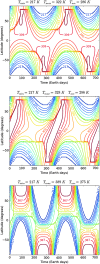Effects of extreme obliquity variations on the habitability of exoplanets
- PMID: 24611714
- PMCID: PMC3995117
- DOI: 10.1089/ast.2013.1129
Effects of extreme obliquity variations on the habitability of exoplanets
Abstract
We explore the impact of obliquity variations on planetary habitability in hypothetical systems with high mutual inclination. We show that large-amplitude, high-frequency obliquity oscillations on Earth-like exoplanets can suppress the ice-albedo feedback, increasing the outer edge of the habitable zone. We restricted our exploration to hypothetical systems consisting of a solar-mass star, an Earth-mass planet at 1 AU, and 1 or 2 larger planets. We verified that these systems are stable for 10(8) years with N-body simulations and calculated the obliquity variations induced by the orbital evolution of the Earth-mass planet and a torque from the host star. We ran a simplified energy balance model on the terrestrial planet to assess surface temperature and ice coverage on the planet's surface, and we calculated differences in the outer edge of the habitable zone for planets with rapid obliquity variations. For each hypothetical system, we calculated the outer edge of habitability for two conditions: (1) the full evolution of the planetary spin and orbit and (2) the eccentricity and obliquity fixed at their average values. We recovered previous results that higher values of fixed obliquity and eccentricity expand the habitable zone, but we also found that obliquity oscillations further expand habitable orbits in all cases. Terrestrial planets near the outer edge of the habitable zone may be more likely to support life in systems that induce rapid obliquity oscillations as opposed to fixed-spin planets. Such planets may be the easiest to directly characterize with space-borne telescopes.
Figures












References
-
- Abe Y., Abe-Ouchi A., Sleep N.H., and Zahnle K.J. (2011) Habitable zone limits for dry planets. Astrobiology 11:443–460 - PubMed
-
- Armstrong J.C., Leovy C.B., and Quinn T. (2004) A 1 Gyr climate model for Mars: new orbital statistics and the importance of seasonally resolved polar processes. Icarus 171:255–271
-
- Barnes R. and Quinn T. (2004) The (in)stability of planetary systems. Astrophys J 611:494–516
-
- Barnes R., Greenberg R., Quinn T.R., McArthur B.E., and Benedict G.F. (2011) Origin and dynamics of the mutually inclined orbits of υ Andromedae c and d. Astrophys J 726:71–78
-
- Butler R.P., Wright J.T., Marcy G.W., Fischer D.A., Vogt S.S., Tinney C.G., Jones H.R.A., Carter B.D., Johnson J.A., McCarthy C., and Penny A.J. (2006) Catalog of nearby exoplanets. Astrophys J 646:505–522
Publication types
MeSH terms
LinkOut - more resources
Full Text Sources
Other Literature Sources
Miscellaneous
